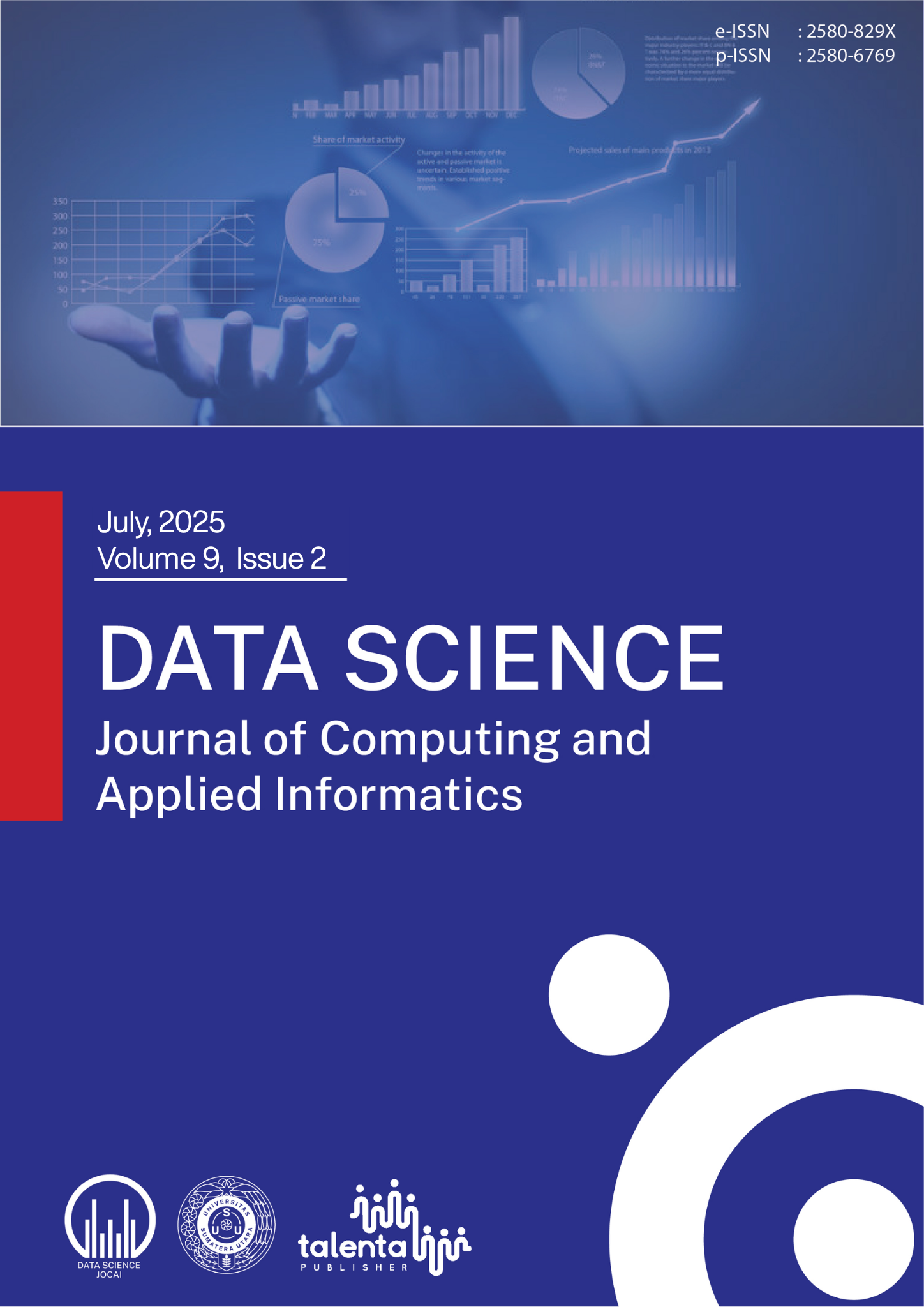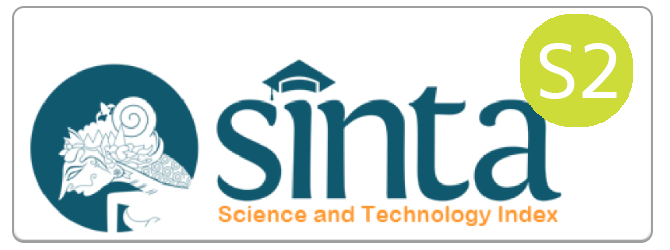Spatial Clustering Analysis of Stunting in North Sumatra Based on Environmental Factors Using K-Means Algorithm
DOI:
https://doi.org/10.32734/jocai.v9.i2-17179Keywords:
Stunting, Spatial Clustering, K-Means, Environmental Factors, Silhouette CoefficientAbstract
This research aims to analyze the spatial grouping of stunting events in North Sumatra based on environmental factors using the K-Means algorithm. The data used in this research includes the incidence of stunting, environmental factors (such as access to health services, living environment conditions, water use and sanitation), and spatial data (geographical coordinates). The data comes from Basic Health Research (RISKESDAS 2018, then processed and normalized. The elbow method and silhouette analysis are used to determine the optimal number of clusters, resulting in four different clusters. The application of the K-Means algorithm produces the following cluster characteristics: Cluster 1, with good environmental conditions and access to health services, shows low levels of stunting; Cluster 2, with moderate environmental conditions, shows moderate levels of stunting; Cluster 3, which is characterized by poor living conditions and limited access to health services, has levels high stunting; and Cluster 4, with varied environmental conditions but very limited access to health and sanitation services, also shows a high stunting rate. Validation using the Silhouette Coefficient produces an average score of 0.65 which indicates good clustering quality shows that environmental factors, access to health services, and sanitation conditions have a significant impact on the incidence of stunting. Based on these findings, policy and intervention recommendations are focused on Clusters 3 and 4, which have high stunting rates. The interventions carried out include increasing access and quality of nutrition, health services, sanitation conditions, economic empowerment, and health education.
Downloads
References
W. Hadikurniawati, K. D. Hartomo, And I. Sembiring, “Spatial Clustering of Child Malnutrition in Central Java: A Comparative Analysis Using K-Means And DBSCAN,” In Proceedings: ICMERALDA 2023 - International Conference on Modeling And E-Information Research, Artificial Learning And Digital Applications, Institute of Electrical and Electronics Engineers Inc., 2023, Pp. 242–247. Doi: 10.1109/ICMERALDA60125.2023.10458202.
T. Vaivada, N. Akseer, S. Akseer, A. Somaskandan, M. Stefopulos, And Z. A. Bhutta, “Stunting in Childhood: An Overview of Global Burden, Trends, Determinants, And Drivers of Decline,” Am J Clin Nutr, Vol. 112, Pp. 777S-791S, Sep. 2020, Doi: 10.1093/AJCN/NQAA159.
A. A. Azis and A. Aswi, “Spatial Clustering of Stunting Cases in Indonesia: A Bayesian Approach,” Communications in Mathematical Biology and Neuroscience, Vol. 2023, 2023, Doi: 10.28919/Cmbn/7898.
S. Supadmi Et Al., “Factor Related to Stunting of Children Under Two Years with Working Mothers in Indonesia,” Clin Epidemiol Glob Health, Vol. 26, P. 101538, Mar. 2024, Doi: 10.1016/J.CEGH.2024.101538.
A. N. W. S. Saimu, “Penanganan Resiko Stunting Berbasis Data Tingkat Kecamatan Mawasangka Tengah Kabupaten Buton Tengah,” Jurnal Inovasi Penelitian, Vol. 4, No. 1, Pp. 75–87, 2023.
A. Yusuf, “K-Means Clustering Based on Distance Measures: Stunting Prevalence Clustering in South Kalimantan,” In 2022 5th International Seminar on Research of Information Technology and Intelligent Systems, ISRITI 2022, Institute of Electrical and Electronics Engineers Inc., 2022, Pp. 706–710. Doi: 10.1109/ISRITI56927.2022.10052925.
H. Sulastri, H. Mubarok, And S. S. Iasha, “Implementasi Algoritma Machine Learning Untuk Penentuan Cluster Status Gizi Balita,” Jurnal Rekayasa Teknologi Informasi (JURTI), Vol. 5, No. 2, P. 184, Dec. 2021, Doi: 10.30872/Jurti.V5i2.6779.
I. P. Sari, Al-Khowarizmi, F. Ramadhani, A. Satria, And O. K. Sulaiman, “Leukocoria Identification: A 5-Fold Cross Validation CNN And Adaboost Hybrid Approach,” 6th International Seminar on Research of Information Technology and Intelligent Systems, ISRITI 2023 - Proceeding, Pp. 486–491, 2023, Doi: 10.1109/ISRITI60336.2023.10467242.
F. Ramadhani, M. Zarlis, And S. Suwilo, “Improve BIRCH Algorithm for Big Data Clustering,” In IOP Conference Series: Materials Science and Engineering, Institute of Physics Publishing, Jan. 2020. Doi: 10.1088/1757-899X/725/1/012090.
K. P. Sinaga and M. S. Yang, “Unsupervised K-Means Clustering Algorithm,” IEEE Access, Vol. 8, Pp. 80716–80727, 2020, Doi: 10.1109/ACCESS.2020.2988796.
A. Satria, O. S. Sitompul, And H. Mawengkang, “5-Fold Cross Validation on Supporting K-Nearest Neighbour Accuration of Making Consimilar Symptoms Disease Classification,” In Proceedings - 2nd International Conference on Computer Science and Engineering: The Effects of The Digital World After Pandemic (EDWAP), IC2SE 2021, Institute of Electrical and Electronics Engineers Inc., 2021. Doi: 10.1109/IC2SE52832.2021.9792094.
P. Thongnim, E. Charoenwanit, And T. Phukseng, “Cluster Quality in Agriculture: Assessing GDP And Harvest Patterns in Asia and Europe with K-Means and Silhouette Scores,” 2023 7th International Conference on Electronics, Materials Engineering and Nano-Technology, Iementech 2023, 2023, Doi: 10.1109/IEMENTECH60402.2023.10423469.
L. Kaufman and P. J. Rousseeuw, Finding Groups in Data. Wiley, 1990. Doi: 10.1002/9780470316801.
D. Danila, I. D. Pawa, A. Choiruni, A. Wijayanti, “Geospatial Analysis Pada Prevalensi Stunting di Kabupaten Manggarai,” Berita Kedokteran Masyarakat, Vol. 34, No. 11, 2018.
M. De Onis, E. Borghi, M. Arimond, P. Webb, T. Croft, K. Saha, L. M. De-Regil, F. Thuita, R. Heidkamp, J. Krasevec, C. Hayashi, “Prevalence Thresholds for Wasting, Overweight and Stunting In Children Under 5 Years,” Public Health Nutr, Vol. 22, No. 1, Pp. 175–179, Jan. 2019, Doi: 10.1017/S1368980018002434.
Downloads
Published
How to Cite
Issue
Section
License
Copyright (c) 2025 Data Science: Journal of Computing and Applied Informatics

This work is licensed under a Creative Commons Attribution-ShareAlike 4.0 International License.















